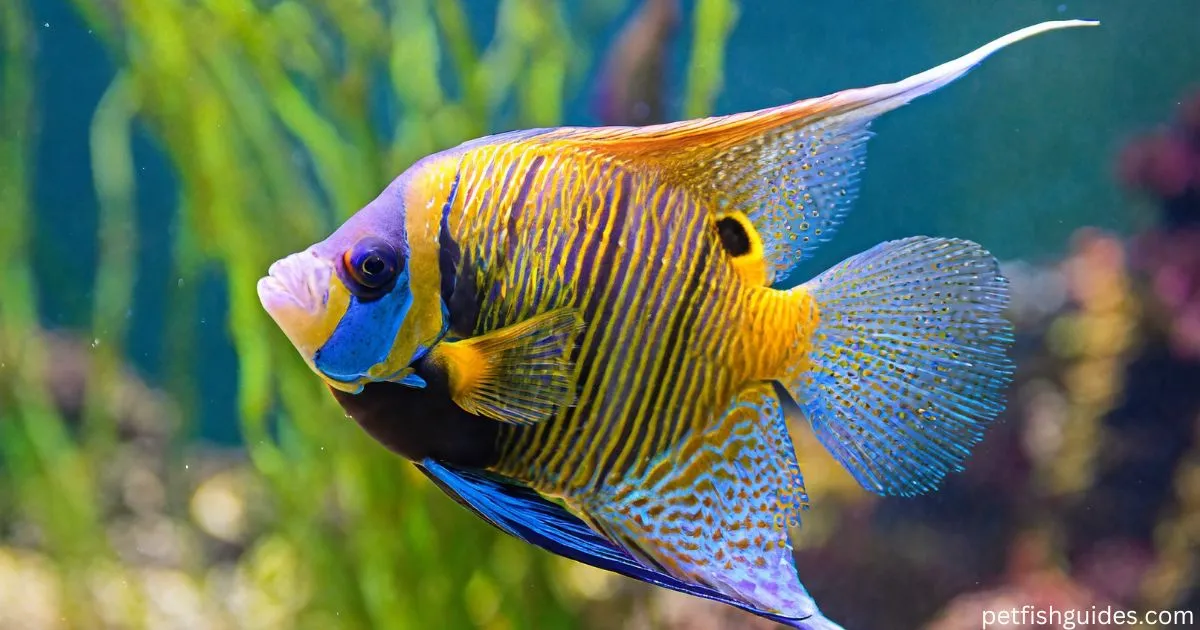Selecting the right saltwater angelfish tank size is crucial for keeping these tropical beauties healthy and thriving. Though popular for their colors and fins, each angelfish variety has specific gallonage needs for its living space. An improperly sized tank can inhibit their health and natural behaviors.
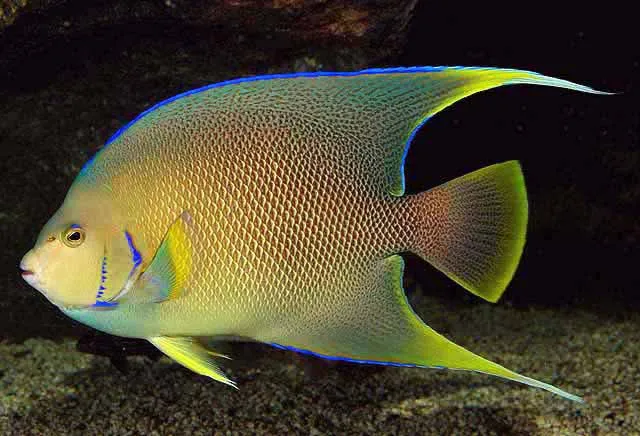
This beginner’s guide will focus on recommended minimum tank sizes for popular saltwater angelfish varieties. You’ll discover key factors impacting the ideal housing requirements for Emperor, Flame, Coral Beauty, Dwarf, and Koran angelfish. With the right aquarium size tailored to your species, you can create a dazzling and comfortable saltwater habitat. We’ll provide tips for optimizing tank setup too. Let’s dive into the specifics of saltwater angelfish tank sizing to keep your fish happy and healthy for the long run!
Understanding Saltwater Angelfish
Saltwater angelfish comprise over 100 species displaying unique colors, patterns, and body shapes. Some popular varieties are the emperor, flame, coral beauty, dwarf, and koran angelfish. While sizes vary, most species need sizable tanks with ample horizontal swimming space. Their behavior ranges from peaceful to semi-aggressive.
Read More About Saltwater Angelfish….
Emperor Angelfish Tank Size.
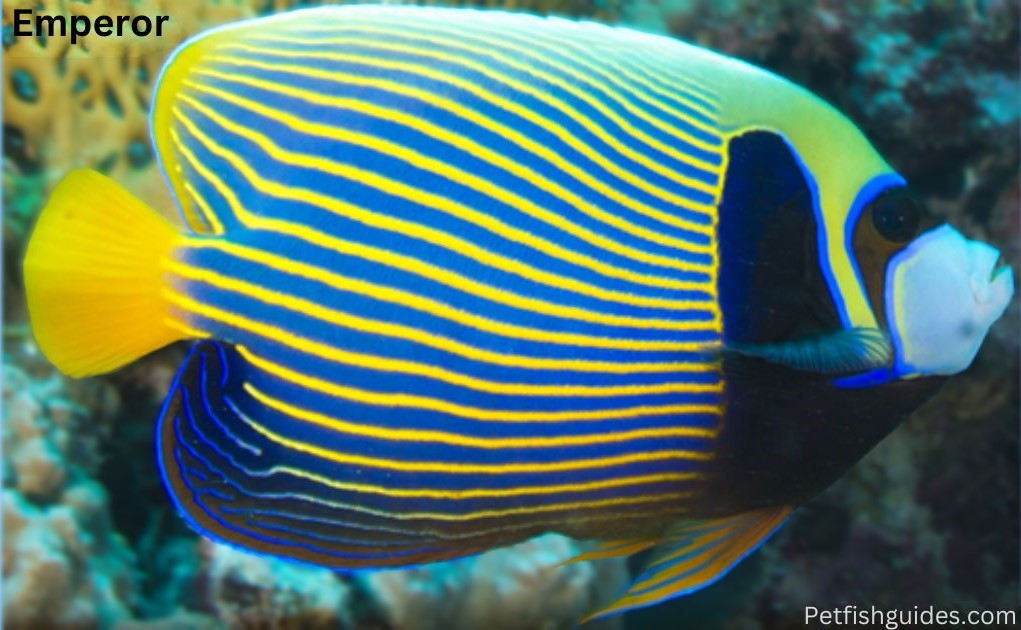
Distinguished by their circular body shape and bold black, white, and yellow coloring, emperor angelfish commands attention in any saltwater tank. These fish can grow up to 10 inches long as adults.
For adult, the minimum recommended emperor angelfish tank size is 125 gallons. This allows them adequate swimming room to exhibit natural behavior. Smaller tanks under 100 gallons will stunt their growth.
For a Juvenile, Emperor angelfish tank size should be 75-gallon but will need an upgrade once they mature. The tank should be taller than wide, with peaceful tank mates suitable for their semi-aggressive temperament.
Flame Angelfish Tank Size.
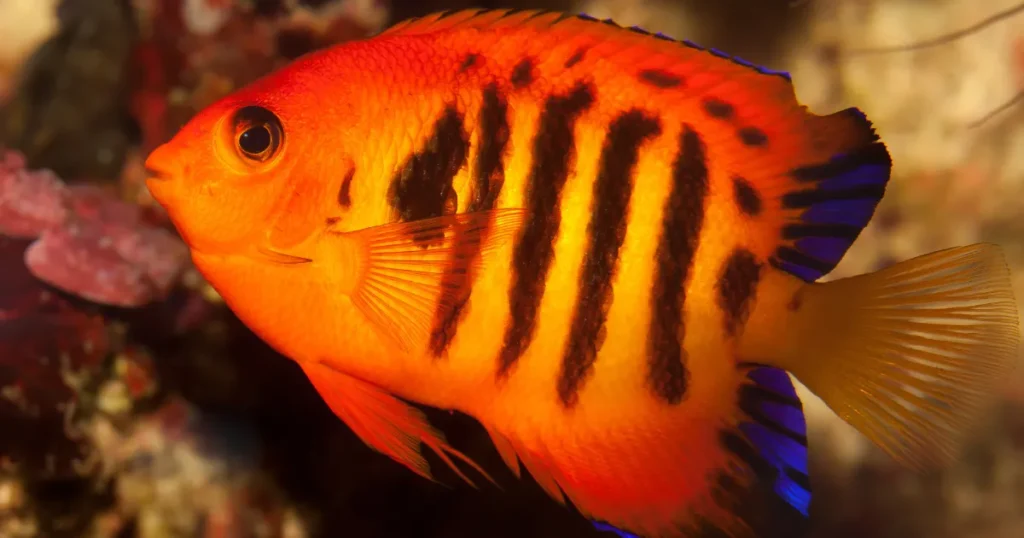
Flame angelfish dazzle with their bright reddish-orange bodies and bold black stripes. Native to the Indo-Pacific, they reach 5-6 inches in length when mature.
The minimum tank size for flame angelfish is 55 gallons. However, a 70 to 90-gallon tank is ideal to accommodate their active swimming habits. The tank should also be longer than tall, providing necessary horizontal swimming space.
Flame angelfish do well alone or with peaceful community fish. Avoid housing them with semi-aggressive tank mates. Overcrowding causes stress, making ample tank room essential.
Coral Beauty Angelfish Tank Size.
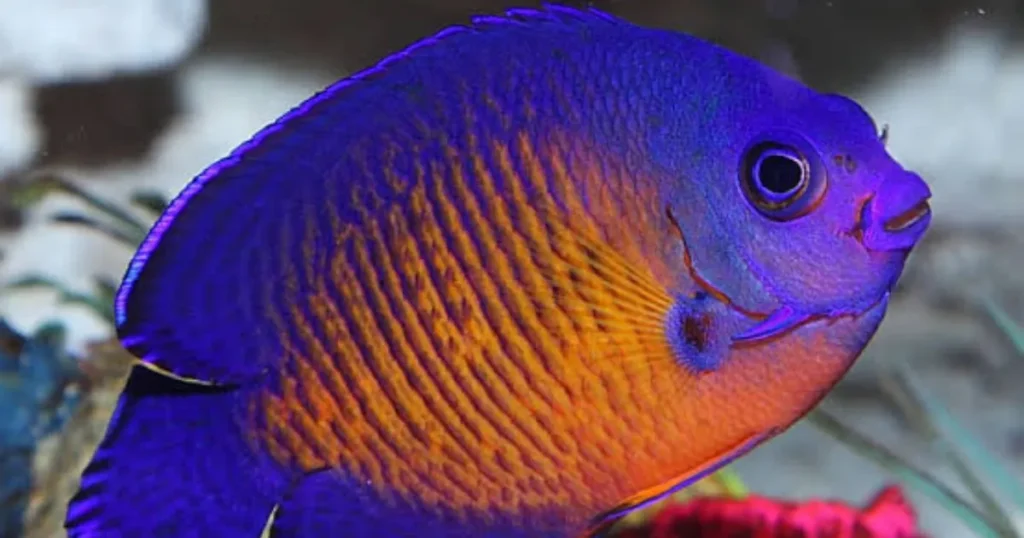
Also called dual bar angelfish, the coral beauty sports a deeply forked tail and bars across its face. These reef dwellers max out around 4 inches long.
For a single, the bare minimum coral beauty angelfish tank size needs to be 55-gallon. However, a 75-gallon or larger tank is recommended to thrive truly. This allows uninhibited swimming and plenty of live rock for grazing and hiding.
Multiple coral beauties can be kept in a 125-gallon or 180-gallon tank. This larger water volume dilutes aggression and provides adequate territory. Never house coral beauties in tanks under 30 gallons.
Dwarf Angelfish Tank Size.
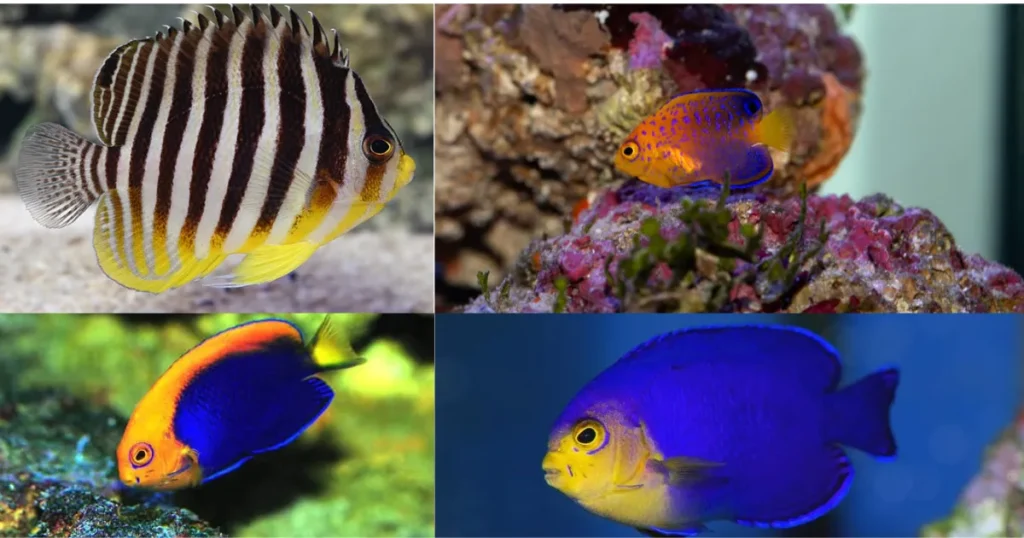
“Dwarf” refers to a group of small-bodied angelfish species reaching just 3-4 inches long. Some popular dwarf varieties are:
- Cherubfish
- Keyhole Angelfish
- Flameback angelfish
For most dwarf species, a minimum 29-gallon tank is recommended. A 40-gallon breeder provides even better swimming space. Make sure any tank mates are peaceful and reef-safe.
Dwarfs still require excellent aquarium upkeep and water quality. While small in stature, they deserve ample room to exhibit natural angelfish beauty and behaviors.
Koran Angelfish Tank Size.
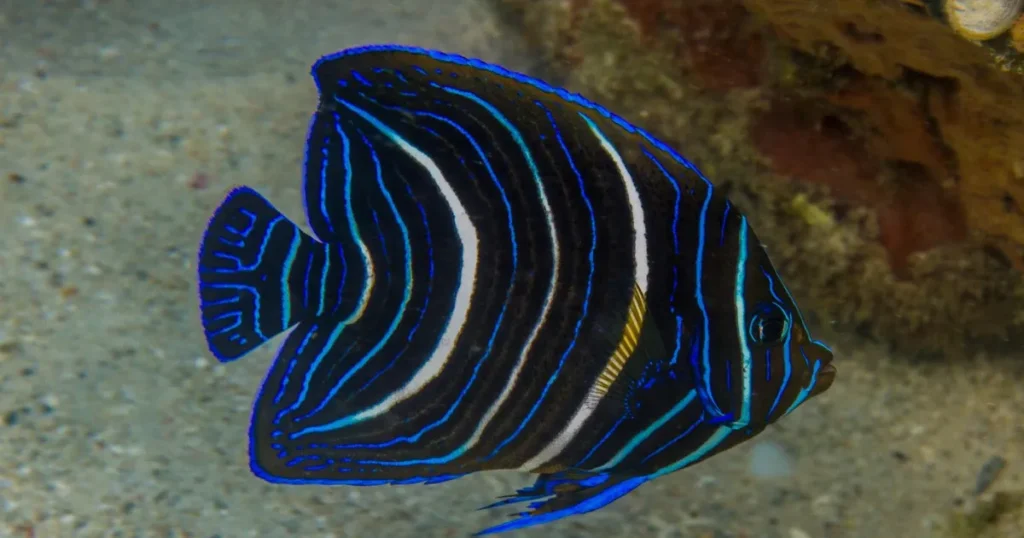
The Koran angelfish boasts vertical black and white stripes with a rounded shape. Growing up to 10 inches long, they need sizable aquariums.
For Koran angelfish, aim for a minimum 120-gallon tank as an adult. They can start in a 75-gallon tank while juvenile before being moved to their permanent larger home.
Make sure the tank has plenty of live rock for grazing and hiding spots. Koran angelfish thrive in reef aquariums with fish tank mates of comparable size and temperament. Never mix them with aggressive species.
Factors Influencing Saltwater Angelfish Tank Size Requirements.
When figuring out the ideal saltwater angelfish tank size, there are a few key factors to consider:
- Adult Size – Consider the maximum length and dimensions a species can reach. Emperor angelfish over 10 inches needs more room than a 3-4 inch dwarf species.
- Swimming Space – Angelfish are active swimmers, especially in the horizontal plane. Make sure the tank length and width allow free movement.
- Behavior – Some angelfish are more shy, others more bold. Aggressive species need ample territory.
- Grouping – A single angelfish needs less space than a mated pair or community tank.
- Decor – Allow room for live rock, corals, plants and other tank structures angelfish will interact with.
Setting Up the Ideal Saltwater Environment.
Optimizing tank setup goes beyond just size. Be sure to include:
- Proper Tank Dimensions – Longer tanks provide needed horizontal swimming room.
- Hiding Spaces – Incorporate caves and crevices in live rock for retreats.
- Appropriate Lighting – Cater lighting to species; most do well with moderate levels.
- Water Flow – Angelfish appreciate gentle currents; provide adequate filtration.
- Reef-Safe Décor – Live rock, corals, and plants recreate native habitat.
- Consistent Testing – Routinely check water parameters like salinity, pH, and ammonia.
- Partial Water Changes – Change 10-15% biweekly to maintain pristine water quality.
Challenges and Solutions.
Limited space poses challenges for housing angelfish:
- Maximize swimming space by choosing longer, rectangular tanks over tall ones.
- Rearrange rockwork and decor to open up the room. Remove clutter.
- Upgrade tank size gradually as angelfish grows by starting juveniles in smaller tanks.
- Keep just one focal angelfish variety as a showcase specimen if space-constrained.
- Let aggression subside before adding new tank mates; don’t overstock.
Monitoring and Adaptation.
Keep close tabs on angelfish to ensure their needs are met:
- Note any territorial displays, lack of appetite, or skittish behavior.
- Regularly measure angelfish to see if upgrades are needed as they mature.
- Be ready to move fish to larger tanks if they appear cramped.
- Introduce tank dividers if aggression arises between angelfish pairs.
- Remove problematic decor or structures if impeding swimming patterns.
FAQs.
What is the minimum tank size for a flame angelfish?
The recommended minimum flame angelfish tank size is 55 gallons. However, a 70-to 90-gallon tank is better to accommodate their active swimming.
How many emperor angelfish can go in a 125-gallon tank?
A 125-gallon tank is large enough for 1-2 adult emperor angelfish. More than that risks overcrowding.
What size tank does a dwarf angelfish need?
Most dwarf angelfish varieties require at least a 29-gallon tank, but a 40-gallon breeder is ideal. They need horizontal swimming space.
Can I mix different angelfish species in the same tank?
It’s generally best to avoid mixing angelfish varieties unless you have a very large tank of 180+ gallons. Each species has different needs.
Should my angelfish tank be tall or long?
Angelfish do best in tanks that are longer than tall, providing more horizontal swimming room for their body shape.
How often should I upgrade my angelfish tank size?
Expect to upgrade tank size every 1-2 years as juvenile angelfish grows. Adults may need upgrades every 3-5 years.
What are signs my angelfish tank is too small?
Lethargy, loss of appetite, skittishness, and aggression can signal a tank size is inhibiting healthy behavior.
How many gallons do I need per angelfish?
Aim for around 20 gallons per average-sized angelfish, slightly more for larger varieties. This ensures adequate territory.
Conclusion
Providing your saltwater angelfish with an adequately sized tank tailored to their specific needs is crucial for their health and well-being. While the tank requirements vary slightly between popular angelfish species, bigger is always better when it comes to aquarium size and volume.
Aim to provide the largest tank possible for the angelfish variety you are keeping. This gives them plenty of horizontal swimming space to exhibit natural behaviors. Be sure to factor in their full adult size and temperament when choosing tank dimensions.
While a bigger tank may require more initial investment, optimizing their living space pays off down the road with healthy, thriving angelfish. You’ll be rewarded with more active fish, brilliant colors, and interesting behaviors on display. The beauty of a properly housed angelfish aquarium is truly dazzling.
Focus first on providing excellent water quality, appropriate tank mates, and ample territory through tank size. Meet your angelfish’s fundamental needs, and they will flourish for years to come. We hope this beginner’s guide gave you the insights needed to help your angelfish thrive. Let us know if you have any other questions as you set up the ideal saltwater environment.

